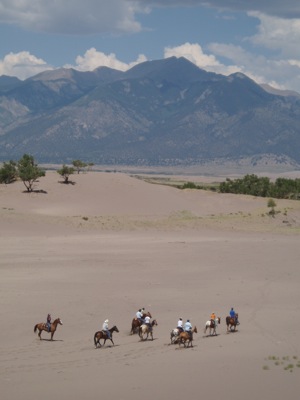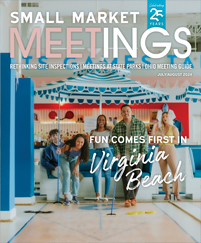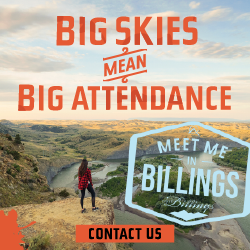
Courtesy Zapata Ranch
Admit it.Once upon a time, you wanted to be a cowboy.
Evidence? The photo of you, age 6, standing square in your cowboy boots, six-shooter in hand, pint-size 10-gallon hat on your head. The hopeful look that said, “Pony?”
As you grew up, the Old West and the pony became an old dream. Ropin’ and ridin’ were not your calling, and the saddle got traded for a seat at the boardroom table.
But those youthful fantasies needn’t be dismissed. Today’s guest ranches are rounding up corporate meetings as they become more than a family vacation destination.
Mixing horses and high-powered executives is a natural, said Nicholas Gold, the acting general manager at Tanque Verde Ranch near Tucson, Ariz., where meeting-goers can begin their day with an hour-long horseback ride followed by coffee among the Saguaro cacti and pancakes cooked over a mesquite fire.
“Most people, at a certain time in childhood, wanted to be a cowboy or Calamity Jane,” said Gold.
Research supports his statement. Years ago, Wrangler, the jeans-maker, did a survey that showed that three of five men and nearly half of women have wanted to be a cowboy for at least a day.
“People have that one on their bucket list at some point,” said guest ranch owner Taunia Elick. “We enjoy sharing it with them.”
Colleen Hodson, executive director of the Dude Ranchers Association (DRA) based in Cody, Wyo., said her association’s members more assertively pursue meetings.
Hodson estimates that when she joined the DRA eight years ago, about 10 percent of DRA members actively marketed to meetings. Today, it is upward of 60 percent.
The shift has required minimal changes at ranches — they’ve added meeting space, boosted technology, invested in some amenities like spas — upgrades that are as pleasing to the typical dude ranch guest as they are to the meeting attendee.
Boots give a boost
To meet in such an atypical setting provides psychological advantages, ranchers say. “It allows you to get out of your own head, to be that child again,” said Gold.
Hodson has noticed that when her board meets at a ranch, work gets done faster. She theorizes that the group is more efficient because its members are itching to get out and enjoy the ranch.
“When we meet at a hotel, I feel that we don’t get near the stuff accomplished that we would at a ranch,” she said.
Elick, coowner of the Texas Ranch Life, sees a physical transformation when meeting attendees arrive at her family’s 1,800-acre ranch, one hour northwest of Houston. Often, guests have taken Elick’s advice and purchased new Western wear at nearby shops.
“When they put on the boots and the hat, it literally changes a person They get a foot taller and start walking bowlegged,” said Elick.
Go west for ranches
Guest ranches tend to be in the West, although there are a few in Florida, Ohio, New York and other states. The largest concentration of Dude Ranchers Association members is in Colorado, Montana and Wyoming, but not all guest ranches are members of DRA; for example, Texas Life Ranch does not belong to the association.
Ranches typically stretch thousands of acres; by comparison, their meeting space is miniscule, rarely exceeding 5,000 square feet. Housing is typically limited too, with the number of guest rooms in the double digits.
Roughing it not required
Going to a ranch doesn’t require roughing it. For example, Lost Valley Ranch in Sedalia, Colo., is in its 34th consecutive year as a AAA Four Diamond recipient; the Home Ranch in Clark, Colo., is a member of the prestigious Relais and Chateaux group.
UXU Ranch in Wapiti, Wyo., touts its gourmet meals, long wine list, down duvets and microfiber robes; Lost Creek Ranch, near Jackson, Wyo., has a full-scale spa.
At Zapata Ranch in Mosca, Colo., chef Mike Rosenberg once worked for the Carnegie family and catered the wedding of John Kennedy Jr.
Most of the ranches raise cattle, and in many cases, the cattle are for more than show. The herd at Texas Ranch Life, spotlighted on the History Channel production Meat America, provides lean steaks for guests.
“We are really into homemade and homegrown,” said Elick.
Many of the vegetables served are raised on the ranch; Elick has plans to plant an orchard next year.
A mixed herd of European heritage provides hormone-free beef at Sylvan Dale Ranch near Rocky Mountain National Park in Colorado, where owner Susan Jessup said guests consistently praise the food.
“Our food isn’t fancy exotic or gourmet; it is just good food,” she said.
Meals might include locally raised watermelon, cinnamon rolls baked according to Jessup’s late mother’s recipe or freshly made oatmeal and chocolate chip cookies.
Resort features added; rustic feel retained
Today’s ranches aren’t just about cattle drives and horseback rides; a number have added swimming pools, spas, ropes courses and other elements typical of traditional resorts. “We have a new addition this year,” said Yancy Arterburn of Mountain Sky Ranch in Emigrant, Mont., “A golf course. That will be huge for us.”
At Texas Life Ranch, Elick continues to add lodging by using indigenous ranch buildings. Some are given to her, others are purchased and all are saved from destruction, preserved and prettied up in a style that suits the German heritage of the area in an upscale fashion.
Most also maintain a rustic feel and ranch activities, even as they add high-end touches like high-thread count sheets and other frilly features that would make a cowboy wince.
Black Mountain Ranch in McCoy, Colo., promises longhorn cattle drives every week and a fully licensed saloon for sipping sarasparilla. Zapata Ranch was one of Conde Nast Traveler’s Three Best Ranches in America for a Real, Working Ranch Vacation. Dude ranch owners are in their fourth generation at Lazy E-L; in their third at Triangle C Ranch in Dubois, Wyo.
“We always say it is rustic elegance,” said Arterburn, at Mountain Sky Ranch. “We’ve taken older buildings and refurbished them, adding wood floors, tile baths, slate surrounds. We’ve created a luxury environment but are being careful to preserve the Western feel.”
Guests can work with the cowboys
Among the dude ranches are working ranches, where guests can labor alongside ranch hands. An example is Zapata Ranch, a 103,000-acre cattle and bison ranch that borders the nation’s newest national park, Great Sand Dunes National Park and Preserve.
Zapata was purchased 12 years ago by the Nature Conservancy and is managed by a third-generation ranch family.
The ranch is also a laboratory for conservation practices, an element that might entice corporations or associations with an environmental mission.
“We are a working ranch where people come out, and whatever we are doing that day they are welcomed to go with us. They are getting the real deal,” said David Leach, director of marketing. “Education is a part of everything we do.”
So if cattle need to be moved from one pasture to another, “we make a plan, spread out and work together,” he said.
Meetings are held in a small, restored barn beneath wooden beams; meeting attendees stay in one of three five-bedroom houses that include an 1800s log lodge and a log bunkhouse.
The buildings have been restored, and although they appear rustic, they are modern inside. The meeting barn has wireless Internet access and the latest audio-visual equipment; rooms are dressed in Western decor but sport tile baths and windows that open.
Western Resource Advocates, a regional conservation organization based in Boulder, Colo., chose Zapata Ranch in part, because it is owned by the Nature Conservancy, and because it was “it was a good place to see parts of the state and the West that we are interested in protecting,” said John Nielsen, energy program director.
The softer side: customer service
Although rugged and rustic, ranches are surprisingly attune to customer service.
“These guys are probably the best in customer service I have ever been around,” Hodson said.
She credits Western hospitality, but there’s also the ranch work ethic to consider. On the ranch, everyone is expected to pitch in and help, no matter the task.
Ranch staff pride themselves in knowing guests by name, and they’ve developed ways to help staff do so.
“When guests come in, their picture goes up on a board in the back,” said Hodson.
Guests often comment on the professionalism of staff at Sylvan Dale Guest Ranch in Colorado, run by second-generation rancher Jessup.
“They say, ‘Your staff is so wonderful; you must have quite a service-training program,’” Jessup said. “We don’t have a training program at all. I just hire caring people. My philosophy is if you hire truly caring people they will deliver the services quite naturally. You don’t have to teach them to say, ‘Thank you for shopping at our Wal-Mart.’”
A Mountain Sky’s guest once told Arterburn the service there was comparable to what the guest had experienced at the Four Seasons Hotel in Istanbul, Turkey.
“We always say we hire personality and teach them to do the rest,” said Arterburn.
Jessup credits the fact that most ranches are family operations, handed from one generation to the next. “It is like coming to somebody’s home, and not like going to some corporate-owned business. A ranch is much more personal.”











